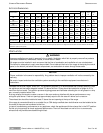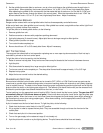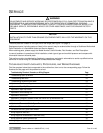
U
LTIMATE
R
ESTAURANT
R
ANGES
I
NSTALLATION
O
WNER
’
S
M
ANUAL
1190820
REV
3
(11/10) P
AGE
15
OF
48
I
NSTALLATION
NOTICE
These installation procedures must be followed by qualified personnel or warranty will be void.
Local codes regarding installation vary greatly from one area to another. The National Fire Protection Association,
Inc., states in its NFPA 96 latest edition that local codes are the “authority having jurisdiction” when it comes to
installation requirements for equipment. Therefore, installations should comply with all local codes.
The installation must conform with local codes, or in the absence of local codes, with the National Fuel Gas Code,
ANSI Z223.1, Natural Gas Installation Code, CAN/CGA-B149.1, or the Propane Installation Code CAN/CGA-
B149.2, as applicable, including:
1. The appliance and its individual shutoff valve must be disconnected from the gas supply piping system during
any pressure testing of that system at test pressures in excess of 1/2 psi (3.45 kPa).
2. The appliance must be isolated from the gas supply piping system by closing its individual manual shutoff valve
during any pressure testing of the gas supply piping system at test pressures equal to or less than 1/2 psi (3.45
kPa).
NOTICE
EXHAUST FANS AND CANOPIES: It is recommended that the range be installed under a ventilation hood.
Consult local codes for proper installation of hoods. Proper ventilation is the owner’s responsibility. Any problem
due to improper ventilation will not be covered by warranty.
NOTICE
In the Commonwealth of Massachusetts all gas appliances vented by either mechanical systems or ventilation
hoods shall comply with 248 CMR interlocking requirements.
S
TEP
1:
U
NPACKING
IMMEDIATELY INSPECT FOR SHIPPING DAMAGE
All containers should be examined for damage before and during unloading. The freight carrier has assumed
responsibility for its safe transit and delivery. If damaged equipment is received, either apparent or concealed, a
claim must be made with the delivering carrier.
Apparent damage or loss must be noted on the freight bill at the time of delivery. The freight bill must then be
signed by the carrier representative (Driver). If the bill is not signed, the carrier may refuse the claim. The carrier
can supply the necessary forms.
A request for inspection must be made to the carrier within 15 days if there is concealed damage or loss that is not
apparent until after the equipment is uncrated. The carrier should arrange an inspection. Be certain to hold all
contents plus all packing material.
Do the following:
1. Cut the banding straps and remove the corrugated cardboard surrounding the range. If legs were shipped in the
same container, set them aside for installation in later steps of this procedure. Do not remove any tags or labels
attached to the range until the range is installed and working properly.
2. Lift the flue riser and shelf (if applicable) off the range and set it aside for installation later in this procedure.
3. Unbolt the shipping hold-down brackets from the skid, then remove the brackets from the range. Replace the
bolts back into the threaded holes in the range.
4. If the range is to be installed on legs, go to Step 2a.
If the range is to be installed on casters, go to Step 2b.


















